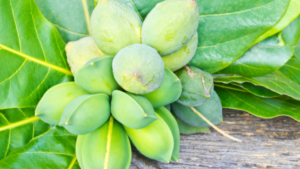Introduction
The tropical almond or Indian almond tree is a vital Indian medicinal plant. The scientific name is Terminalia catappa and belongs to the family Combretaceae. This article is about the Tropical almond fruit benefits and description.
It is a large spreading tree distributed throughout the tropics in coastal environments (1). The plant is generally evergreen or briefly deciduous depending on the locality.
The leaves and fruits of this plant are astringent. The sap of the leaves also treats leprosy and dysentery, also helps in curing pain, and dresses swollen rheumatic joints (2).
Botanical description

Height
10-35 meters tall with smooth grey bark and whorled branches.
Leaves
The leaves are about 13-22 cm long and 12-17 cm wide. all the leaves are spirally arranged or clustered at the end of branches. Dark green above and paler beneath, lathery and glossy in appearance.
Flowers
Sessile and greenish-white in color. they are very small having no petals but 10-12 conspicuous stamens.
Fruits
Hard, 7 cm in diameter, green-red, round and flattened, egg shape having two ridges but no wings. the seeds of these fruits are in tough covering or fibrous husk (2).
The main compounds present in the Tropical almond tree
Compounds present in Tropical almond trees are tannins, flavonoids, and triterpenoids. The bark contains gallic acid, ellagic acid, glucose, punicalagin, corilagin, and many more (3). The fruits of this tree contain corilagin, brevifolin-carboxylic-acid, beta-carotene, cyanidin-3- glucoside, ellagic acid, gallic acid, glucose, and pentosans (4).
Tropical almond fruit benefits and other medicinal properties

The fruits and leaves of the plant Tropical almonds are rich in chemicals like tannins, saponins, and phytosterols and thus have so many important medicinal properties. Tropical almond fruit benefits are thus as follows.
1. Antibacterial activity
The fruits and leaves of the plant Tropical almond possess anti-bacterial activity against corynebacteria (causes diphtheria), staphylococci (skin infections), enterococci (gut infection), Escherichia, salmonella (diarrhea, fever, and stomach cramps), and shigella (intestinal infections) (3).
2. Antioxidant activity
Ellagic acid present in the fruits of Tropical almonds shows strong antioxidant activity (5).
3. Analgesic activity
The extract of leaves and fruits possess analgesic activity thus helping in reducing mild or moderate pain (6).
4. Antidiabetic activity
Fresh and unripe green fruits of Tropical almonds possess anti-diabetic activity. In experiments on the animal model, it was observed that the extract of fruits of this plant helps in reducing the blood sugar level to 25-60 % within 15 days of administration (7).
5. Hypocholesterolemic activity
Tropica almonds reverse the altered lipid levels to the normal range in tumor-bearing mice (8).
Terminalia catappa fruit extract and fallen dry leaf decoction have also been reported to have hypocholesterolemic effects on the animal model (9).
6. Wound healing property
The plant Terminalia catappa is reported to have wound-healing properties. Besides this, it also exhibits anticancer, aphrodisiac, and antiaging properties (10).
Other medicinal properties of Tropical almonds
- The fruits act as a cooling agent. The fruits are aphrodisiac in. nature and act as an astringent to the Bowles. Also used to treat bronchitis.
- Seeds of tropical almonds is having almost the same properties as real almonds. The leaf paste is used for skin treatments for various skin diseases like scabies and leprosy.
- The juice is taken to reduce headaches.
- This plant is having other properties like a diuretic, and cardiotonic and also is applied externally on skin eruptions.
- Other nonmedicinal uses of these plants are the tannin leather pf the leaves are used to dye clothes and for making ink (11).
How to grow and take care of Tropical almond
Propagation
The main mode of propagation of this tree is via seeds. With germination in 3-8 weeks. Vegetative propagation by rooted cutting is also possible.
Soil
Standard potting media is required with freely draining sandy looms having good organic manure.
Sunlight
Good tropical weather is most appropriate for the healthy growth of this plant. thus needs good sunlight for better growth.
Pest attack
Susceptible to termite attack. Leaves may be eaten by various insects like rose beetles. But generally, the plant can heal by itself by defoliation.
